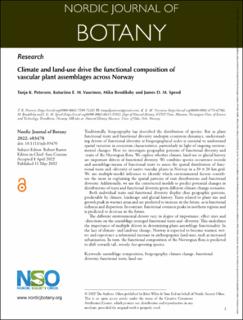| dc.contributor.author | Petersen, Tanja Kofod | |
| dc.contributor.author | Vuorinen, Katariina Elsa M | |
| dc.contributor.author | Bendiksby, Mika | |
| dc.contributor.author | Speed, James David Mervyn | |
| dc.date.accessioned | 2023-02-24T15:11:43Z | |
| dc.date.available | 2023-02-24T15:11:43Z | |
| dc.date.created | 2022-05-16T22:37:20Z | |
| dc.date.issued | 2022 | |
| dc.identifier.citation | Nordic Journal of Botany (NJB). 2022, 2022 (7), . | en_US |
| dc.identifier.issn | 0107-055X | |
| dc.identifier.uri | https://hdl.handle.net/11250/3053996 | |
| dc.description.abstract | Traditionally, biogeography has described the distribution of species. But as plant functional traits and functional diversity underpin ecosystem dynamics, understanding drivers of functional diversity at biogeographical scales is essential to understand spatial variation in ecosystem characteristics, particularly in light of ongoing environmental changes. Here we investigate geographic patterns of functional diversity and -traits of the Norwegian flora. We explore whether climate, land-use or glacial history are important drivers of functional diversity. We combine species occurrence records and assemblage-means of functional traits to assess the spatial distribution of functional traits and -diversity of native vascular plants in Norway in a 20 × 20 km grid. We use multiple-model inference to identify which environmental factors contribute the most in explaining the spatial patterns of trait distributions and functional diversity. Additionally, we use the constructed models to predict potential changes in distributions of traits and functional diversity given different climate change scenarios.
Both individual traits and functional diversity display clear geographic patterns, predictable by climate, landscape and glacial history. Traits related to plant size and growth peak in warmer areas and are predicted to increase in the future, as is functional richness and dispersion. In contrast, functional evenness peaks in northern regions and is predicted to decrease in the future.
The different environmental drivers vary in degree of importance, effect sizes and -directions on the assemblage-averaged functional traits and -diversity. This underlines the importance of multiple drivers in determining plant assemblage functionality. In the face of climate- and land-use change, Norway is expected to become warmer, wetter and experience a substantial increase in anthropogenic land-uses, such as increased urbanisation. In turn, the functional composition of the Norwegian flora is predicted to shift towards tall, woody, fast-growing species. | en_US |
| dc.language.iso | eng | en_US |
| dc.publisher | John Wiley & Sons Ltd on behalf of Nordic Society Oikos. | en_US |
| dc.rights | Navngivelse 4.0 Internasjonal | * |
| dc.rights.uri | http://creativecommons.org/licenses/by/4.0/deed.no | * |
| dc.title | Climate and land-use drive the functional composition of vascular plant assemblages across Norway | en_US |
| dc.title.alternative | Climate and land-use drive the functional composition of vascular plant assemblages across Norway | en_US |
| dc.type | Peer reviewed | en_US |
| dc.type | Journal article | en_US |
| dc.description.version | publishedVersion | en_US |
| dc.source.volume | 2022 | en_US |
| dc.source.journal | Nordic Journal of Botany (NJB) | en_US |
| dc.source.issue | 7 | en_US |
| dc.identifier.doi | 10.1111/njb.03470 | |
| dc.identifier.cristin | 2024986 | |
| dc.source.articlenumber | e03470 | en_US |
| cristin.ispublished | true | |
| cristin.fulltext | original | |
| cristin.qualitycode | 1 | |

